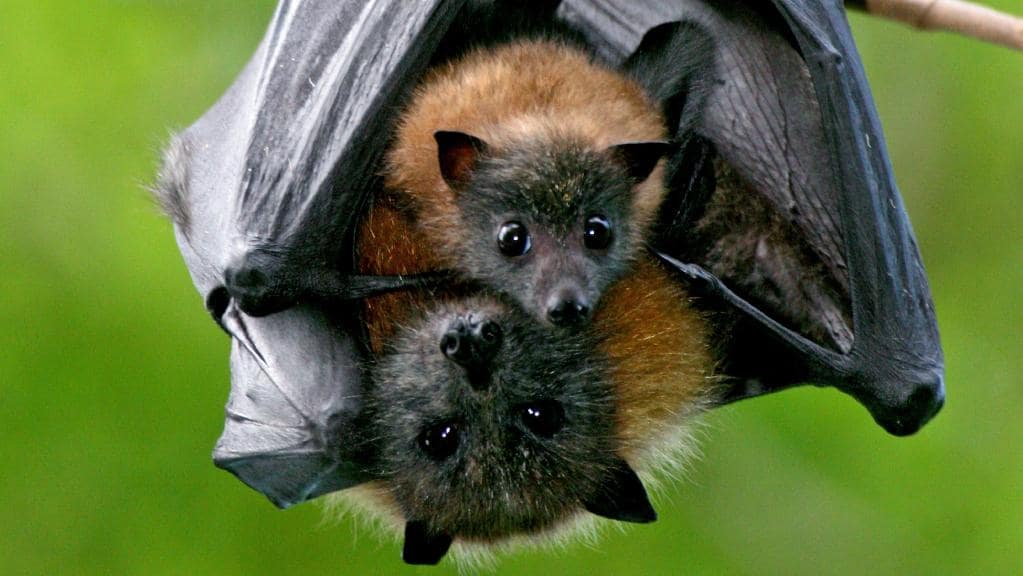Fear2Fascination:Bats
Myth: Bats are blind, rabid, blood sucking rodents.
Truth: Aww. The wonderful world of Chiroptera (translated to hand wing from its latin origin) has maintained its bad reputation for centuries. Contrary to the myths, there are quite a few species of bats that hunt with eyesight instead of echolocation, prefer insects over blood, and are as rabies-free as you are. . . Oh, and FYI, NEVER call a bat a flying rat- they can get quite offended.
DID YOU KNOW?
You may be thinking 'flying mouse', but you are thinking wrong. Even though bats may look like an aerobatic mouse, they are closer related to humans than their squeaky look-alikes. However, one thing they do have in common with rodents are their numbers. Although there are more species in the Order Rodentia, bats come in at a close second with over 1,300 species in the Order Chiroptera. These winged marvels account for one-fifth of all mammals on the planet.
Mexican free-tailed bats emerge from Texas’s Bracken Cave. Over 15 million bats live there, making it the largest known bat colony (and largest concentration of mammals) on Earth. Photo by Ann Froschauer, USFWS.
Bats are the only mammals capable of flight. As mentioned earlier, their name, Chiroptera, translates to hand wing. Their entire wing looks very similar to a human hand covered in a flexible skin sheath, called a patagium.
FUN FACT: If humans could grow our fingers to match a bat of our size, they would be over 7 feet long.
Biologist inspects bat wing. credit USFWS/Ann Froschauer
Bats used to be divided into two groups based on morphology and size: Megabats and Microbats. Now -thanks to genetic research- the two groups are called Yinpterochiroptera and Yangochiroptera.
The Yinpterochiropteran group includes all the fruit bats (from flying foxes to tiny nectar eaters) which live in the Old World tropics and subtropics, but are not found in North and South America – one species (the Egyptian fruit bat) just about makes it to Europe.
Yangochiroptera are found worldwide. They are what is left of the microbat species. These species feed primarily on insects, but some are also know to hunt lizards, birds, fish, frogs, and even feed on blood.
All mammals have the possibility of transmitting rabies, but bats aren't as bad as you think. It was once thought that around 10% of bats were vectors (carriers) of rabies, but a study conducted in 2011 shows that this number may be as low than 1% .
Even so, it is never smart to touch a bat.
Researchers use cotton swabs to retrieve saliva samples from the mouths of bats captured near Flagstaff to detect the rabies virus. Photo by Jake Bacon
Without bats, say goodbye to your favorite foods and even some medicines. Over 300 species of fruit depend on bats for pollination. Bats help spread seeds for nuts, figs and cacao -- the main ingredient in chocolate. Without bats, we also wouldn’t have plants like agave or the iconic saguaro cactus. In addition to food crops, about 80 medicines come from plants that rely on bats for their survival. Even the dreaded vampire bat is helping the medical world by aiding stroke and heart attack victims with their anti-coagulating saliva.
Night insects have the most to fear from bats. Each night, bats can eat their body weight or more in insects, numbering in the thousands! This insect-heavy diet helps foresters and farmers protect their crops from pests. A group of scientists led by Thomas Kunz at Boston University calculated how much more money cotton farmers in one region of Texas would spend on pesticides if bats weren’t present. Extrapolating from those numbers, they estimated that bats save American farmers somewhere between $3.7 billion and $54 billion a year, most likely about $22.9 billion.
Contrary to what many people think, there are only 3 species of vampire bats in the world (Remember there are over 1300 total bat species, so 3 is really nothing). They are the only mammals to survive exclusively on blood. But despite this seemingly ruthless trait, they are quite cooperative with their fellow colony mates. Relying on a diet of pure protein, vampire bats are very susceptible to starvation. They don’t put on fat, they don’t store energy, and they can starve if they miss more than two meals. However, if a fellow roost mate becomes sick or lethargic, other bats in their roosts will often regurgitate a portion of their blood meals to feed them. . . How charitable! . . .Stay tuned. There will be a myth buster just on this guy!
Photo credit: Nat Geo Kids
Bats have few natural predators -- disease is one of the biggest threat to our US bats. Owls, hawks and snakes eat bats, but that’s nothing compared to the millions of bats dying from White-Nose Syndrome. The disease -- named for a white fungus on the muzzle and wings of bats -- affects hibernating bats and has been detected in 31 states and five Canadian provinces. More than 6.5 million bats have died so far from White-Nose Syndrome.
The northern long-eared bat has been hit hard by white nose syndrome. It was recently listed as threatened by the U.S. Fish and Wildlife Service.
U.S. FISH AND WILDLIFE SERVICE HEADQUARTERS /
You can make a difference for bats. Many people don't know bats are so good for the environment and, more importantly, for humans. Here are some of my favorite ways to help bats.
Become a bat advocate. Tell your friends and family the truth about bats.
Stop using pesticides in your garden. Would you want to eat poisoned food?
Put up bat boxes. Bats are losing their homes to deforestation and habitat loss.
Plant a Bat-Friendly Garden:
Planting night-scented flowers, which attract insects
Creating a pond
Putting up a bat box for bats to roost in
Letting your garden go a bit wild - neatly pruned gardens aren't as good for insects
Making sure you don't use any chemicals or pesticides on your garden
Ask an adult to help you find out more about how to garden for bats - they can visit our 'Encouraging Bats' page for more information
Do you know any AMAZING bat facts? Share them below!
COME FOLLOW THE ADVENTURE













